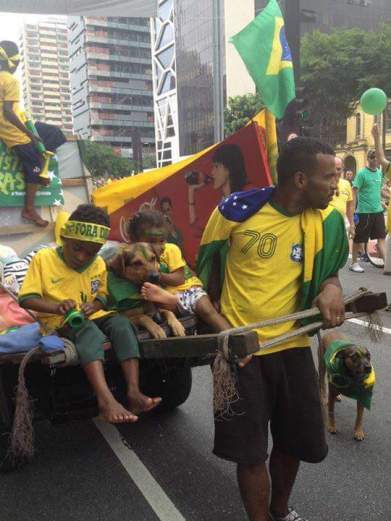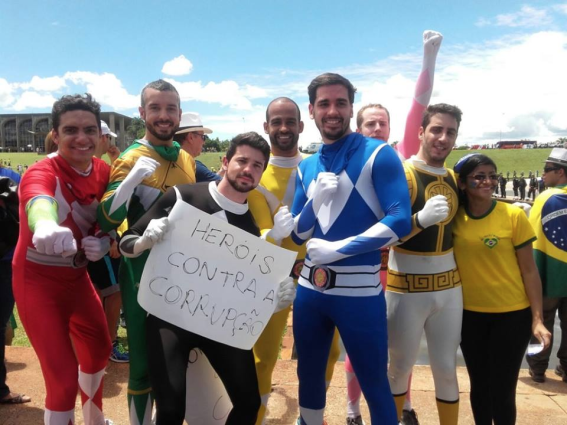You are what you share.
A lot of people went to protests against corruption in Brazil this past Sunday

A big question is who went and why
Supporters of the protests argued they were a legitimate expression of the Brazilian people’s frustration with government corruption. Opponents criticized the protests, claiming they were were overrepresented by a white economic elite more interested in advancing their own political interests than seriously combating corruption.
Some protestors were in fact from the elite


Though this wasn’t necessarily representative of all present

Some protestors were less concerned with corruption than with what Brazil could become

Or with how much of their money was going to the government

Or with whom this was benefiting

Shirt reads: Dilma wasn’t elected by the people who read newspapers, but by the people who clean themselves with them. Dilma Out
Or with food?

Or with, well… ???

Some were just feeling nostalgic

Main targets of the protests were current President Dilma, former President Lula and the leftist Worker’s Party (PT).




The opposition party didn’t come out unscathed
Governor of Sao Paulo Geraldo Alckmin and Senator of Minas Gerais Aécio Neves, both former presidential candidates from the right of center Social-Democratic Party of Brazil (PSDB), were booed when attempting to participate in the protests, protests which they themselves had supported. Both have been accused of corruption.

They’re a protest movement in search of a hero. But who do you turn to when everybody is corrupt?

Sign one reads: We want all corrupt politicians in jail, from the PT, PSDP, PP or PQP (Wherever the hell they’re from)! Sign two reads: Cunha (the opposition President of the Chamber of Deputies from the PMDB also accused of corruption), we haven’t forgot about you!
A judge?

The police?

The far right?

The military?

Donald Trump?

A fast food chain and an Austrian school of economics?

The Power Rangers?

Final Thoughts:
More than anything, Sunday’s protests highlighted an underlying trend of increased polarization and mistrust in Brazilian politics. A deteriorating economy and a weakened central government can’t be helping. Those who attended the protests, mostly people from the right, view supporters of the government as good-for-nothing mooching hypocrites who will support the PT’s crimes as long as they get welfare benefits, without any concern for the way the party is apparently driving the country to economic ruin. Meanwhile those who objected to the protests view the opposition as elitist/racist/sexist/paternalistic/etc. hypocrites, uncomfortable with the social changes that the PT has brought about in recent year and unaware or uninterested in the harsh reality of Brazil for the most vulnerable sectors of the country’s population. Both sides are haunted by ghosts: the left by memories of a military dictatorship that only ended 31 years ago and the right by fears of a Castro-style Communist takeover.
The protests also brought out two less-talked-about protagonists: a far right mistrustful of both the mainstream center-right political elite and the center-right mainstream media and an ideologically-unfixed middle mistrustful of politics in general, who only want to see lawbreakers punished and have somewhere to direct their anger. The direction this middle swings the next few years could determine the shape of Brazil’s political landscape.
A few questions remain: How serious of a problem actually is corruption in Brazil relative to other issues like poverty, education and violence? Can it be fought against in a bipartisan fashion? If not, should it be combatted in a partisan fashion regardless?
They are especially important in a political climate where plausibly denying the implications of one’s beliefs takes precedence over responsible coalition building.
Were there any images that I missed? Feel free to share with me in the comments.
Also for an article I did on a different kind of Brazilian protest from 2013, see here.